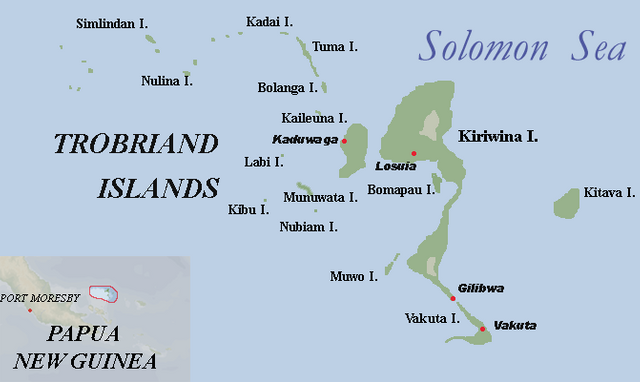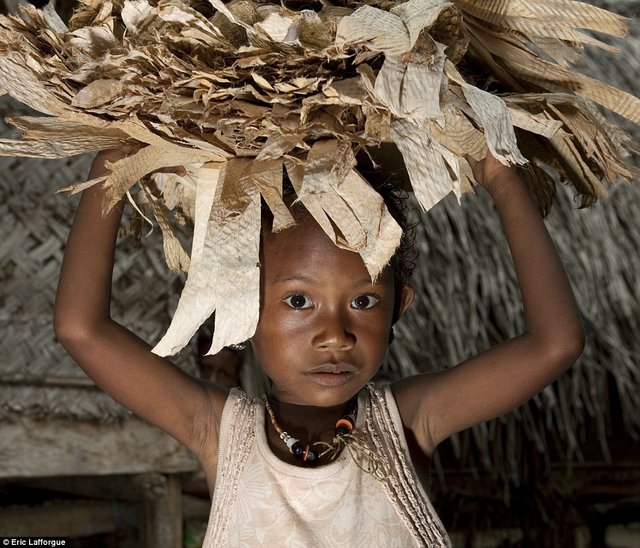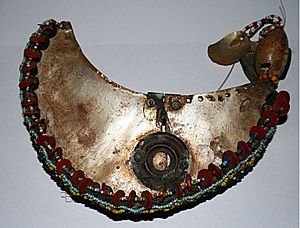The role of gift and commodity exchange in the Trobriand Islands of Papua New Guinea
Gift exchange and commodity exchange is an integral component of the social, political, and business life of the inhabitants of the Trobriand Islands of Papua New Guinea. 
By giving and exchanging gifts and commodities, relationships are formed and strengthened, needs are met, and exchange ensures that the individuals of the Trobriand Islands are reciprocally dependent on one another. This writing will discuss the role of gift and commodity exchange in the Trobriand Islands, with reference to Weiner’s (1998) ethnography and other writings which mention the society of the people of the Trobriand Islands.
Rus (2008) explains the debate about the difference between gift and commodity exchange. The essence is that gift exchange is a gift given by a person or a group of people to one person or a group of people who is counted as a relative or as a friend, and bears the obligation to reciprocate a gift of the same value or of greater value. Giving a gift involves imparting some of the giver’s personality onto the receiver. The receiving of a gift also holds a debt of a friendship and social connection. Commodity exchange is when the items exchanged are of less personal nature, and where there is no social debt attached. It is more of a business transaction of necessary items. Individuals in the Trobriand Islands give or exchange similar produce and crafted items which are given as a gift or traded as a commodity for the personal, social, political, and survival purposes. Gifts and commodities are exchanged by both women and men.  Carrying dried banana leaves (cash)
Carrying dried banana leaves (cash)
Women fill very important roles in the Trobriander Islander’s matrilineal society (Weiner, 1988), meaning the people of the Trobriand Islands recognise kinship through the maternal linage of decent. Men work to become powerful, and may hold places of position according to their wealth and social power. Through marriage, men can grow their store of yams (through the woman’s male relatives working to grow and supply the yams). Stocks of yams signify their wealth. Women’s wealth consists of piles of banana leaves and skirts made from the fibre of banana leaves. Weiner (1988) stated that the women “manufacture and control the distribution of their wealth” (p. 28).
Weiner (1988) wrote in detail of the distribution of women’s wealth soon after there was a death of a man. Certain members of the man’s family and kinship were workers in the long mourning process, while closer family members were the mourners. A woman’s wealth is evident in the amount given for distribution of the piles of the banana leaves and skirts as payment to the workers in the morning process, and payment to all who have been socially connected to the deceased. The act of mourning and the giving for distribution of the items is also significant in showing to others that they were not involved in the cause of death of the deceased (whose death is often thought to be the sorcery work of someone with evil intents). Other items and produce are exchanged for diverse reasons.
Weiner (1988) mentioned that betel nuts and tobacco is given by a would-be lover to seduce their partner. This gift carries expectation of favour in return. Men, who travel from his home island to another island, seek trustworthy partners who they can influence through giving gifts of their produce (taro or yams) or of their crafting (stone axe heads, pandanus mats, and woven baskets) to do ‘kula’ with. (Weiner, 1998) “Doing kula’ has deep traditional roots and continues through the passage of time and through different stages of change. Kula exchange helps to make a man known and famous even amongst people who he does not know. Giving a trustworthy partner their adorned shell and/or necklace bears a trust in the partner to pass it, in good time, to a further trustworthy partner, and so on until the ‘kula’ gift is returned to the original owner, and then passed around again and again.
Trobriander men are in competition with one another to secure specific partners who live on different islands “who engage in a series of relationships with one another” (Henry, 2016, p. 11), and ensure the path of travel of the shell product. An experienced ‘kula’ worker is learned in the ways of ensuring a successful path by which their particular treasure will be transferred to generate increasing fame and honour for him, which elevates his political standing in the society. As the shell product, which bears the original owner’s name along with the names of the men who have held it for a time (Henry, 2016), passes from one to another it grows in value and fame according to the men who have held it for a time, and the distance it has travelled. (Eriksen, 2010).
 A picture of a kula necklace with distinctive red shell disc beads
A picture of a kula necklace with distinctive red shell disc beads
Kula exchange works on the “principle of equivalence” (Henry, 2016, p. 13) in that the practice is to match the “size and value” of one shell or shell product with the other. The ‘kula’ arm-bands, each cut from the “cross-section of a cone shell” (Leigh and Perry, n.d.), and decorated with “egg cowry shells” (Leigh and Perry, n.d.) travel from partner to partner in a counter-clockwise direction, and are considered to be female. The beautifully decorated necklaces are made from “red disk beads cut from chama shells” (Leigh and Perry, n.d.) travel clockwise, and are considered to be ‘male’. The armbands and necklaces are “ranked according to their size, colour, polish, and their particular histories” (Henry, 2016, p. 13). Lee (2011) explains that the rule of the opposite flow ensures that “ongoing relationships will be complimentary” (p. 482). The “giving and receiving’ of the shell products “is associated with myths, rituals, magic practices” (Henry, 2016, p. 11). Sea-travelling Trobriander men also journey with commodities for exchange, which is separate from their ‘kula work’.
Commodity exchange voyages may coincide with Trobriander men’s visits for ‘kula work’ or may be a sole-purpose voyage. (Henry, 2016). Items taken for product exchange may be stone axes, fishnets, dried fish, etc. Commodity exchange may involve taking products which are in abundance in one area to another area where the products do not exist. The exchange would be for something that is equally unavailable, and helps bring variety and necessary materials into the lives of the Trobriand Islands’ people.
Lee (2011) states that “gifts are the main device used to invest in social relationships” (p. 481). Kinship relations in the Trobriand Islands seem to be pronounced by their unique product, for example, cooked taro are given between brother and sister; uncooked small yams are given between a wife’s brother and her sister’s husband; banana leaves and skirts are given between “women of different matrilines (Gregory, 1997, p. 54). Weiner (1988) concluded that “long yams, bundles of dried banana leaves, and strings of polished red shell discs all have all occupy a deep and meaningful place in Trobriand life” (p. 159). These are what can unite people and bind them “socially and politically” (p. 159). Pigs, food, and trade store goods can be exchanged for bundles of dried banana leaves (which loose their value with age) although women make most of their wealth (many bundles) themselves. (Weiner, 1998). The giving of yams takes on various avenues of importance in the lives of the Trobriander people, yet they must be eaten before they rot.
Through the cultivation and the giving and the exchange of yams for labour, care, kinship debts, or mortuary exchange stores of yams grow and publically signal wealth and political power. (Weiner, 1998). Weiner (1998) explains that a person’s social enhancement begins in early childhood by the gifts (food, earrings, beauty, and magic) that their father bestows on them, and is continued through the father’s kin. Through expansion in connections not from one’s matrilineal line (through parenthood and marriage), social and political potential grows. In a Trobriander’s quest for personal recognition and power, there are many forces that thwart his/her efforts. While kinship and social connections bind people, there is also the potential for creating rejection, alienation, and death. Their life is a life- long quest of great effort to create and exchange gifts and commodities for social standing and necessities. (Weiner, 1998). The social structure of the Trobriander Islands is hierarchical, where chiefs have ultimate authority, power, wealth, and privilege, and are in essence, ‘served’ and made rich by many of the ‘commoners’. A person is born to a place of privilege, and can obtain goods, but can also lose them.
While the society of the people of the Trobriand Islands is relatively free of the world of commerce that Western societies have, their lineage and social ties and laws make a complex society based on the exchange of gifts and commodities. There is the pressure to give in accordance to what is expected, and to match in value in return to what is given. Although outwardly it could seem simplistic, the intricate working of their society is complex, with much tension, and many difficulties.
References
Gregory, C. A. (1997). Savage money: The anthropology and politics of commodity exchange. Amsterdam, The Netherlands: Harwood Academic Publishers.
Henry, R. (2016). AN1001X Lecture 8: Ceremonial gift exchange and the social order. LearnJCU AN1001X. James Cook University: Townsville, QLD. Australia.
Eriksen, T. H. (2010). Exchange and Consumption. In Small Places, Large Issues: An Introduction to Social and Cultural Anthropology. NY: Pluto Press, pp 184-202.
Google Image search (for the pictures).
Lee, J. (2011). Kula and relations capital: Rational interpretation of primitive gift institution. Rationality and Society, 23(4), 475-512.
Leigh, C., & Perry, R. (n.d.). Massim: Trobriand Islands and kula exchange, Milne Bay Province, PNG. New Guinea artefacts Retrieved May, 25, 2016, from http://www.art-pacific.com/artifacts/nuguinea/massim/trobkula.htm
Rus, A. (2008). 'Gift vs. commodity' debate revisited. Anthropological Notebooks, 14(1), 81-102.
Weiner, A. B. (1988). The Trobrianders of Papua New Guinea. Belmont, CA.: Wadsworth: Cengage Learning.